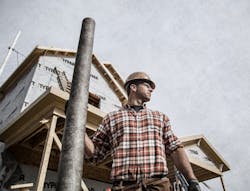A weather-resistant barrier (WRB) alone—no matter how advanced it is—cannot be counted on to protect a structure from unwanted moisture movement without taking the whole assembly into consideration. These materials are part of a holistic approach to airtight construction, or at least they should be. As such, they require thorough, comprehensive integration with other building materials in order to achieve system integrity.
For example, sealants with high solvent or plasticizer content can damage flashing products causing functional and aesthetic issues. Failure to use galvanized cap nails or plastic cap nails to attach the WRB to the sheathing and framing can also compromise performance.
To counter this challenge/issue, some manufacturers have taken a system approach to their building wrap offering where types and flashing have been manufactured to be compatible with each other. When installed together, these systems are often insured through extended warranties from the manufacturer. For instance, The TYPAR® Weather Protection System, which consists of TYPAR® Building Wraps™, flashings, construction tape and fasteners, are engineered to work together and comes standard with a lifetime limited warranty that covers both material and installation, providing an unmatched level of security for both the builder and homeowner.
Equally important to product selection, however, is proper installation of the building wrap system and its components.
Considerations for Building Wrap Installation
Sealing all overlapping seams and penetrations with the proper tape can improve the building wrap’s performance by 20 percent. Horizontal overlapping seams are just as important as vertical laps because windblown rain can travel sideways or even up and over an improperly installed lap. Any tears and holes should be sealed with manufacturer-recommended tapes, and all windows and doors should be properly flashed. The goal should be to create a continuous building envelope free from any penetrations through which air could potentially pass.
During installation, it is also important to follow the proper nailing pattern to ensure the material is kept against the wall and not blown off. Galvanized capped roofing nails or plastic cap staples should be used to attach the WRB material to the structural sheathing and framing. Uncapped nails, staples, or screws can contribute to tearing and moisture intrusion—they must not be overlooked.
The simplest way to ensure the entire system works together effectively and meets all code requirements is to select wrap, tapes, and flashing from a single manufacturer. Doing so provides added assurance each component comes together seamlessly; further, the system could provide a peace of mind through coverage of a manufacturer’s warranty.

